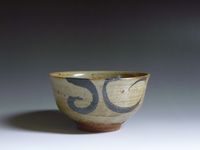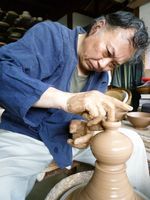

Total:131items
- Pottery & Porcelain (18)
- Koshu Kimen Gawara: Koshu Tile with a Devil’s Face
- Hasami Yaki: Hasami Porcelain
- Kiyomizu Yaki: Kyo style ceramics, Kiyomizu ware
- Otani Yaki: Otani Pottery
- Izushi Yaki: Izushi Porcelain
- Onta-yaki: Onta Pottery
- Takahama Yaki: Takahama Porcelain
- Mushiake- Yaki: Mushiake ware
- Kikuma-Gawara: Kikuma Roof-Tile
- Zeze-Yaki: Zeze ware
- TsutsumiYaki: Tsutsumi Pottery
- Hira Shimizu Yaki: Hira Shimizu Ware
- Tajima Banko Yaki: Tajima Banko Pottery
- Shidoro-Yaki: Shidoro Ware
- Amakusa Tojiki: Amakusa ware
- Shibukusa-yaki: Shibukusa ware
- Karatsu Yaki : Karatsu Ware
- Satsuma-yaki : Satsuma Ware
- Lacquerware (4)
- Glasswork (2)
- Wood & Bamboo Work (19)
- Leather Work (1)
- Papermaking (13)
- Textile (20)
- Dyeing products (5)
- Masonry (1)
- Metal Work (11)
- Stationery (4)
- Livingware (3)
- Accessory (4)
- Toys & Entertainment (14)
- Interior (2)
- Other crafts (10)

 |
Main Production Site:Saga |
 《Characteristics》
《Characteristics》The appeal of Karatsu Yaki (Karatsu ware) is its simple beauty as a tool for daily life. It has the “beauty of service” that is manifested through its functionality -- for serving food and for flower arrangement. A unique warmth and strength can be felt from the raw clay, which is rough and austere.
The glaze used for Karatsu Yaki is “wood ash glaze”, which, as the name suggests, is made of wood ashes. It is used as the basic glaze for Egaratsu (Brush decorated Karatsu ware) and Muji-garatsu (Plain Karatsu ware), as well as most other types of Karatsu ware. The second most commonly used glaze is straw ash glaze, which makes use of the cloudy nature of straw ash. It is used for Madara-garatsu (Mottled Karatsu ware), and for layering with black amber glaze when making Chōsen-garatsu (Korean-style Karatsu ware). Apart from these types of glaze, iron glaze is also often used to make pots.
Clay used for making Karatsu Yaki is mainly clay from Karatsu City, Saga Prefecture, southern Japan, known as “Suname” (in Japanese, “suna” means sand and “me” means eye). The name “Suname” arises not because sand is mixed into the clay but derives from the rough texture of the material. The second most commonly used clay is “fine Suname”, which is strongly adhesive. This clay has parts that are rich in iron and other parts that are not. The former becomes blackish brown after the firing process. As the latter becomes close to white upon firing, pictures drawn on this part of the clay develop a vivid colour.
The characteristics of the main types of Karatsu Yaki are as follows:
[Egaratsu (Brush Decorated Karatsu Ware)]
Patterns such as plants, trees, flowers, birds and people are painted on the raw clay using Oniita (one of the minerals including iron compound that is often used as a material to decorate potteries). Feldspathic glazes and/or limestone glazes are poured over the clay mixture before it is fired to produce Egaratsu.
[Chōsen-garatsu (Korean-style Karatsu Ware)]
Two types of glaze - iron glaze and straw ash glaze are used. Iron glaze is poured over the raw clay first, followed by straw ash glaze (spot glaze), which is poured above the layer of iron glaze. The artwork created from the fusion between the two different types of glaze is Chōsen-garatsu. The style where the iron glazes are put over the straw ash glazes on the clay can also be seen in other Chōsen-garatsu works. (For some Chōsen-garatsu, the order in which the two types of glaze are poured over the raw clay is reversed, i.e. straw ash glaze followed by iron glaze.)
[Madara-garatsu (Mottled Karatsu Ware)]
Raw clay for making Madara-garatsu is covered with a mixture of feldspathic glazes and silica ash. The raw clay becomes opaque and white after being fired in the kiln due to the silica content. Madara-garatsu derives its name from the blue and/or black spots that appear on its surface (mottled surface), as Madara means spots in Japanese.
[Kobiki-garatsu (Slip Karatsu Ware)]
Brown clay is used to make Kobiki-garatsu. Slip (tech: a liquid clay mixture used to decorate pottery) is applied all over the clay when it has not completely dried. Feldspathic and/or wood ash glazes are put over it after the clay has been left to dry.
[Mishima-garatsu]
Mishima-garatsu is a product of infusing Japanese style into the techniques of Mishima Korean pottery, which can be traced back to the Yi Dynasty of Korea (15 - 16th Century). Patterns such as Unkaku (cloud and crane shape) and Inka (flower shape) are printed on the clay before it completely dries and then slip is applied. As a finishing touch, the clay is trimmed or cleaned up, covered with feldspathic and/or wood ash glazes and then fired in the kiln.
[Others]
Other Karatsu ware such as Kigaratsu (Yellow Karatsu ware), Aogaratsu (Blue Karatsu ware), Kurogaratsu (Black Karatsu ware), Hakeme-garatsu (Brush-marked Karatsu ware), Kushime-garatsu (Comb-marked Karatsu ware), Hori-garatsu (Carved Karatsu ware), Jakatsu-garatsu (Scaled Karatsu ware), and Kenjō-garatsu (Karatsu ware for tributes) are named based on their varying colours, patterns, styles and backgrounds, etc.
[Traditional Craft Designated by Minister of Economy, Trade and Industry]
Information provided by Karatsu Yaki Cooperative
Translation by: Mie Nakajima, reviewed by Mavis Chng

| Materials | Clay and glaze such as wood ash glaze and straw ash glaze |
|---|---|
| Crafting Processes | 1. Wedging
The clay is wedged and shaped on a potter’s wheel. 2. Trimming Parts of the clay are trimmed in order to show its features. 3. Bisque (Biscuit) Firing The clay is fired at a low temperature if it is supposed to be underglaze painted or glazed. 4. Underglaze Painting Patterns are drawn on the clay after it is bisque fired. 5. Glazing There are various ways of glazing, such as by immersing the dried/bisque fired clay in glaze and glazing it with a dipper. 6. Loading and Firing Each clay ware is carefully loaded in the kiln for the final firing at a high temperature. |
| History | While there are many accounts about the origin of Karatsu ware, it is regarded to have been first created in the territory of and under the protection of Hata clan, who was the owner of the Kishidake Castle, from the end of the Muromachi era to the Momoyama era (16-17c). Thereafter, the production of Karatsu ware increased with the influx of potters from Chōsen (today’s Korea) who were brought back to Japan after Japan’s Chōsen expedition by Hideyoshi Toyotomi (in 1590’s). These potters started their own potteries in various areas across Japan.
Introduction of techniques from Chōsen such as noborigama kilns (climbing or stepped kilns), pottery kickwheels and glazing increased the variety in styles and types of Karatsu ware. As Karatsu ware came into circulation throughout Japan, it became representative of Japanese pottery and was so well-known that pottery became referred to as “Karatsu-mono” in Western Japan. Furthermore, when it comes to tea, there has been a saying since a long time ago that the best tea cups come from Ido (from Korea), second from Hagi (from present day Yamaguchi Pref., western Japan) and third from Karatsu. Many tea connoisseurs adored Karatsu ware as a masterpiece for tea ceremonies, to the extent that kilns in the Karatsu Domain made Karatsu ware exclusive during the Edo era (17-19c). |
◆Exhibition / Showcase
Exhibition Hall of Karatsu Yaki Cooperatives
Address: Karatsu-shi Furusato Kaikan Arpino, 2nd Floor
2881-1 Shinkou-machi, Karatsu City, Saga Prefecture
Telephone: +81-(0)955-73-4888 / Fax: +81-(0)955-73-9030 (Japanese Only)
Opening Hours: 9:00am - 6:00pm
Closed from December 30th to January 1st each year
◆Event Information
Assistance needed? For inquiries in English:
JTCO Contact Form
Your inquiries will be forwarded by JTCO in Japanese to the organization you wish to contact.
*Please write the name of craft you wish to ask about.



